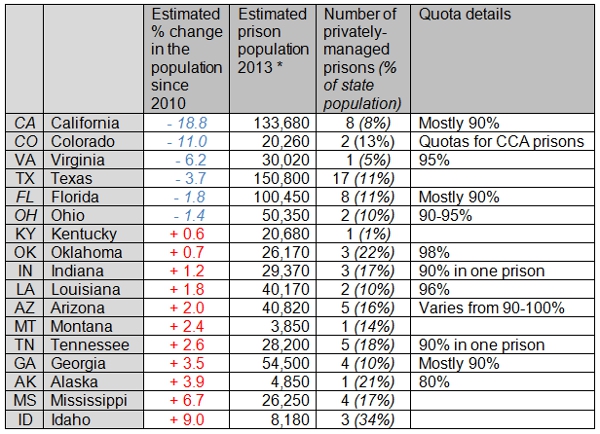 Last Thursday’s post on this blog (and research report) by In the Public Interest (ITPI) shows how U.S. private prison operators have negotiated ‘lockup quotas’ to protect their business against reductions in the prison population. It raises important questions, writes Simon Bastow, about how governments should manage such reductions and the dynamics of entrenched private-sector interests. But to say, as the authors do, that lockup quotas constitute a ‘tax on low crime’ seems like one ideological extrapolation too far. Click here to view a Google Hangout video related to this article.
Last Thursday’s post on this blog (and research report) by In the Public Interest (ITPI) shows how U.S. private prison operators have negotiated ‘lockup quotas’ to protect their business against reductions in the prison population. It raises important questions, writes Simon Bastow, about how governments should manage such reductions and the dynamics of entrenched private-sector interests. But to say, as the authors do, that lockup quotas constitute a ‘tax on low crime’ seems like one ideological extrapolation too far. Click here to view a Google Hangout video related to this article.
In recent months this blog has covered moves in the US criminal justice system towards reducing the size of the prison population. Strong ‘decarceral’ rhetoric by political elites and actual reductions in state-level populations have put increasing pressure on the big private sector prison operators (CCA , MTC , and GEO) to protect their existing market shares.
The research from ITPI gained access to 62 contracts held with these operators, and established that two-thirds include ‘lockup quotas’ that guarantee a certain level of capacity throughout the life of the contract. Indeed some of these have been negotiated in the last few years as prison populations have begun to fall (e.g. in Colorado). I have summarized these in Table 1 at the end of this blog.
Gaining access to these commercial contracts is in itself an interesting research innovation, and one that has important implications for UK commissioning contexts in which it is still practically impossible for the public to access details of these commercial contracts. Inspired by this, I have spent the last few days trawling 50 departments of corrections websites to get some perspective on the overall picture of population reduction and private sector interests in US states.
Figure 1 below shows the variation in prison population reductions since 2010. It is obvious that the most populous states with the highest prison populations have made significant inroads. Indeed, nearly half of all states have reduced their prison populations during this period, while the other half has seen incremental increase. I have marked in red and labelled those states that feature in the ITPI report (see Table 1 below for label codes).
Figure 1: Change in US state-level prison populations between 2010 and 2013

Source: My analysis of prison population statistics on Department of Corrections (DoC) websites, Oct 2013. Data is based on ‘jurisdictional totals’ for most recent month in 2013, and the equivalent month in 2010.
I estimated further the proportion of the total population held in privately-managed prisons in each state. Figure 2 compares the private sector market share and the population reduction rate. It is interesting that Colorado (CO), a state that recently negotiated new lockup quotas with the Corrections Corporation of America shows a considerable rate of reduction in combination with a fairly high private sector market share.
The shape of the relationship between the two variables is potentially interesting here. It suggests, albeit weakly, that the higher the private sector market share, the lower the rate of prison population reduction. This however comes with a giant health warning, and is only a basis for further investigation rather than actual evidence of any kind of malign private sector ‘inflationary’ effect.
Figure 2: Change in prison populations, and comparative size of the privately-managed prison market share

Source: My analysis of prison population statistics on 48 state Department of Corrections (DoC) websites, Oct 2013.
A central argument in the ITPI report is that lockup quotas are in effect ‘taxes on low crime’. In other words, by agreeing to guarantee capacity levels in large private prisons, state governments are effectively constraining their ability to reduce prison population and imposing a cost on taxpayers in doing so.
There are problems with these arguments however. For a start, the case of California (CA) in Figure 2 shows that it is possible to have a sizeable private-sector market, yet make outstanding progress in reducing the overall size of the prison population. As the ITPI’s own analysis shows, California has long had 90 percent lockup quotas in its contracts with CCA and GEO. These have not apparently constrained this stunning decarceral shift.
Second, there seems to be an assumption in ITPI research that there is something necessarily wrong with commissioning services and seeking to run them at something close to full capacity. If a prison is built in the public sector, taxpayers would reasonably expect that ‘value for money’ is maximized, and that the prison is run as close as is feasible (and acceptable) to capacity. Why should the expectation be any different with a private sector prison?
From the contractor’s perspective, they must staff and resource their operations adequately to be able to offer the potential of full capacity to the government client, and it is commercially naïve to expect them to be able to modify their human resources in response to sudden and significant decreases in the prison population. Contractors generally want predictability and clarity in their contractual and operational obligations. Their business models depend on it, and so to, one would think, the quality of services produced.
The UK commissioning model provides an interesting comparison. Here government has traditionally paid for available prisoner places in privately-managed prisons (currently around 15 to 18 percent of the total prison population). If available prisoner places are not used by the government client, they must still be paid for. This has the exact same effect as a lockup quota at 90 percent or 95 percent. In both cases, the contracts determine a central level of agreed predictability in demand – not necessarily a bad thing.
If we can demonstrate that privately-managed prisons provide a systematically lower quality of service or outcomes, or if they are excessively more expensive per prisoner than public sector prisons, the ‘tax on low crime’ argument becomes immediately more persuasive.
ITPI highlight one or two cases of major performance failure in private prisons. Clearly these must be taken seriously, and the challenge for government is to improve incentives and performance-management to minimize this kind of failure. But the lack of sector-wide perspective makes it difficult to establish that lockup quotas are artificially sustaining systemically inefficient (or failing) services. As in the UK, there are good and bad private prisons, just as there are good and bad public prisons. The debate around lockup quotas serves only to shroud a much bigger discussion about comparative performance – and how that can be evidenced in policy-relevant ways.
It is clearly important to see the ITPI arguments in their instrumental context. They have been produced by an organization with a strong (and laudable) public interest objective. As the report shows, many of the existing contracts are up for renewal in the next few years, and state governments will face important decisions about their privately-managed capacity, relative performance, and the economics of signing up to new rounds of contractual obligations. Indeed, some states (e.g. Kentucky) have taken steps to transfer private capacity back into the public sector. This, ultimately, is matter of strategic (and political) decision making by state governments. But as ever, we must be careful of buying into ideological extrapolation without looking in a more balanced way at the evidence and the underlying dynamics.
Table 1: Background data for Figures 1 and 2 above

Source: My own analysis of prison population data on state DOC websites, 2013. In the Public Interest report 2013 (column 4). * All figures taken from the most recent monthly summary of prison population available from the state DOC website.
USApp’s Managing Editor, Chris Gilson, recently spoke to Simon Bastow about this article as part of a Google Hangout. Watch the hangout in the player below:
Please read our comments policy before commenting.
Note: This article gives the views of the author, and not the position of USApp– American Politics and Policy, nor of the London School of Economics.
Shortened URL for this post: http://bit.ly/18VpGyT
Featured image credit: Chris Frewin (Creative Commons BY NC ND)
_________________________________
 Simon Bastow – LSE Public Policy Group
Simon Bastow – LSE Public Policy Group
Simon Bastow is a Senior Research Fellow at the LSE Public Policy Group. He recently published a book with Palgrave Macmillan ‘Governance, performance and capacity stress: The chronic case of prison crowding’. He tweets @simonjbastow.






